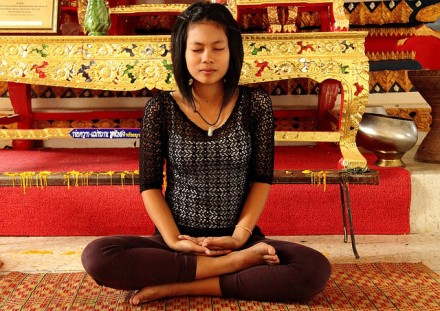
Is there meditation for people who think they can’t do it?
“I know I should meditate. I keep thinking about it but every time I try I get distracted and I just never end up doing it routinely.”
In recent years, meditation is no longer thought of as only for Buddhist Adherents, monks or seekers; it and has been adopted by people of all ages, faiths, ethnicities and backgrounds as part of their spiritual and wellness routine. Meditation has gone from ritual to routine in homes, meditation centers, Churches and health-complexes worldwide.
Many people believe that meditation inspires a quieted mind, the clarity of their Higher Selves, and feeling more attuned with their spiritual selves as well as reaping physical and mental benefits.
Most of us know WHY we should meditate; the physical benefits of meditation are well documented and studied ; the NIH now endorses meditation for the treatment of chronic pain and the University of California, Davis has done a study which correlates meditation with biochemical changes that could support cellular longevity*. Because it’s low-cost and has no side-effects, experts have found meditation to be effective adjunct therapy for many health conditions when combined with a doctor’s care.
Mental advantages of meditation are just as well researched; lessened anxiety, increased concentration, faster response times, better flexibility under stress, increased memory, relaxation and better performance at work and school. Brain scans indicate changes in the brain with meditation that allows us to decide more effectively and to be happier and more enthusiastic.
Many people even know a little bit about how to meditate, but just can’t seem to find the time or drive to do it consistently enough to see the benefits. Those who are the most busy, or the most frustrated with meditation actually need it the most
WHY CAN’T I MEDITATE CONSISTENTLY? WHAT AM I DOING WRONG?

Some of the hidden barriers people have in incorporating meditation practice into their daily lives are ideas like: “I don’t have time for this. Others may, but I don’t.” “I can’t stop thinking!” “I want the fastest, most effective route to the benefits of meditation” or, “I am not doing it right.”
Many of these roadblocks arise from the idea that meditation is something that we attain, or win through doing the exact best method, for just the exact right amount of time, to get optimum results. As with the rest of modern life, we often view meditation in terms of prize/goal objectification. What works better than viewing meditation as something we use, is viewing it as something we are. Instead of some external source that we can reap rewards from, meditation can be seen as illumination and balance of those things that are already within us. It can be a quiet unfolding which helps us find a deeper intrinsic connection between ourselves and all other things that exists within us, hidden from view. As spiritual author Deepak Chopra says, “Meditation is not a way of making your mind quiet. It is a way of entering into the quiet that is already there -buried under the 50,000 thoughts the average person thinks every day”
While there are many meditative techniques and practices (Transcendental Meditation, Zen Meditation, Vipassana meditation) there are a few basic forms that are good for every level of experience.
Mindfulness meditation is about being aware of your surroundings, your body and your thoughts without attaching or focusing on any particular thing, allowing your consciousness to be a fluid observer that gradually releases into a place of calm and detachment from busy-thoughts.
Focused Meditation allows your mind to focus on a sound, an image, or a chanted mantra with your focus on ONE thing instead of many different fragmented thoughts.
Movement Meditation allows your mind to focus on your body in space through repetitive rhythmic movement. This can be something as simple as breathing meditation (focusing on your breath) or as advanced as swaying or walking meditation.
Here’s how to get past the most common blockades:
1) Don’t be afraid to find the meditation practice that is best for you
Nobody can tell you whether or not mindfulness meditation, movement meditation, or guided meditation is better or right for you. Experiment and familiarize yourself with different modalities. Don’t be afraid to explore and learn different techniques but always bear in mind that your own inner energy will align best with what is right only for you. Listen to your intuition and trust your own inner wisdom
2) Allow for frustration.
No matter how long you’ve been meditating, you might find yourself frustrated or uncomfortable at some point. Especially if you are new to meditation you might find yourself thinking about how much you’re thinking, how you’re not relaxed and about what you need to buy at the store later. If you allow yourself to have intrusive or uncomfortable thoughts, you can more easily commit to bringing your attention and focus back to your meditation and release the frustration. Don’t allow meditation to stress you out.
3) Find a comfortable position.
You don’t really need to sit in the lotus position under a Bodhi tree in order to meditate. Wear comfortable clothes and sit in a comfortable position in a serene environment if you can, but meditation can really be done almost anywhere at any time. Many people sit in a straight-backed chair with their feet flat on the floor, but others sit on cushions, or even lie down. Your eyes can be open or closed.
4) Be consistent and don’t give up.
As with other activities, meditation requires active attention, intention and effort. If you find your attention or commitment to meditation waning and flagging, it’s then that you need meditation the MOST. At first, meditation may seem difficult or daunting but it does get easier and more rewarding with practice but trying to monitor your daily progress will not work. Stick with it, but let go of monitoring yourself and you will gradually build a deeper, more beneficial meditation practice and benefit. Find a time every day to meditate and schedule time for this to be part of your day. Many people meditate two times per day; once in the morning and once in the evening.
5) If you get stuck, simply allow yourself to release the frustration you have or the mental chatter you have by gently returning your focus to your breathing or to your mindfulness.
Imagine that you are on a bridge overlooking a stream passing underneath. Thoughts and mental chatter are like twigs and leaves winding down the stream beneath you, they pass by unencumbered and without judgment. You don’t dive in there and focus or run away with any one of them, instead you stay on the bridge.
With a little patience, experimentation, and time, anyone can meditate. Creativity, complex problem solving, emotional health and well being, and improved sleep are all wonderful effects of meditation but perhaps the most important reason is simply to attune with who you truly are, and gain a sense of connection to all things and your spiritual core.
*Intensive meditation training, immune cell telomerase activity, and psychological mediators: University of California, Davis, University of California San Francisco*Article adapted from my previously published article on meditation for practitioners and lightworkers
© 2018 Willow Brilliance in Sight/Psychic Scoop
Check out my website and BLOG for more goodies!
email me or chat with me to schedule an appointment for a 10, 15, 30, or 60 minute session.
I do readings via my chat messenger that anyone can use. Please let me know your time zone and the times most convenient for you.
You can also read more of my articles right here on the Psychic Scoop website.
- Meditation for People Who Think They Can’t - July 8, 2021
- Spotlight Reader of the Week – Willow - June 9, 2021
- 10 Huge Red Flags to Avoid in Dating - March 21, 2018

